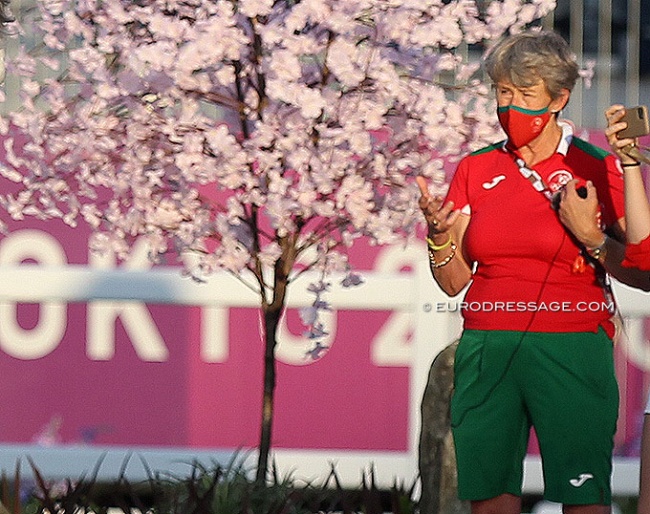
Kyra Kyrklund, six-time Dressage Olympian for Finland, multiple Nordic and Finnish champion in Dressage, Jumping and Eventing, six-time FEI Dressage World Cup™ finalist and winner of the FEI World Cup™ Final with Matador in 1991 talks to Louise Parkes about her life and times. A hugely popular Dressage trainer and advisor, Tokyo 2020 is the 11th Olympic Games she has been involved in.
Matador is still my benchmark. Whatever horse I ride, if they feel like him, I know they are good.
I saw him as a two-year-old and I brought him to Finland as a three-year-old. He didn’t have amazing movement from birth. When you were riding him, even when he was young, he was very sensitive to sound. He wasn’t spooky, but if a mouse farted he could get scared!
Nor, the Grand Prix horse I had before him that I went to Moscow (Olympic Games 1980) with, his conformation wasn’t very good so I always struggled with getting him up in the neck and his hind legs were not the best for a Dressage horse. It was hard for him so I had to push, and it’s not a nice feeling to come out of a Grand Prix arena with your heart in your mouth! So I knew if I got a sensitive horse I just had to wait. When I say sensitive I mean you don’t need to pull or push. Maybe I’m lazy as a rider but riding a horse like that and educating it from the beginning is a much more positive experience.
From Helsinki
I come from Helsinki from a non-horsey family. I always liked animals and we had a summer holiday place near my godmother, who had a farm and I’d ride my bike there to spend all day with the cows and pigs and hens. She had two workhorses and we would sit on them when we were bringing in the hay, and one day when I was 10 years old my godmother’s oldest son and I were playing together and decided we would both ride one of the horses, a mare called Irja. He was in front and I was behind, but a dog got loose and barked and scared her and she started trotting. The boy jumped off and I fell and broke my arm. That wasn’t what worried me that day though, I was more worried about my white shorts and tee-shirt because mammy was going to be really angry with me!
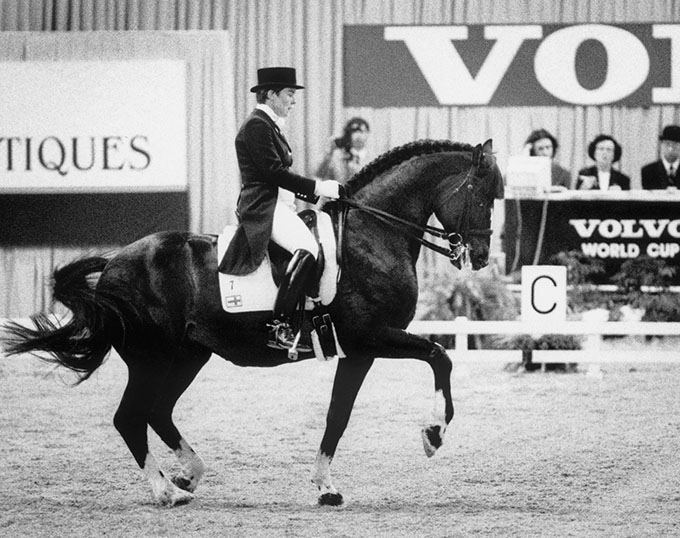
I started jumping with him and we did quite well at our first national show together. We jumped clear in the 1.10m and then won a Junior class and the Chairman of the Finnish Federation asked me if we could jump higher so of course I said yes! It turned out he was looking for a rider for the Finnish Championships and he took me into the team and we ended up winning the team competition and finishing second in the individual! I did a lot of Jumping in those years, right up to 1.50m level. There was not much Dressage in Finland when I started out.
Combination
The combination of Jumping and Dressage is good in my opinion. Nowadays I think many people specialise too early.
If you want to become a professional Dressage rider you have to be able to school young horses and you have to dare to take your bum out of the saddle and maybe ride a bucking horse or ride out the buck on a horse! I would say that one of the reasons I got into Dressage was, that like many other people, I got scared. To go back a little bit, the daughter of the family who owned that first horse eventually wanted to compete him, and in my last Junior year I had nothing to ride.
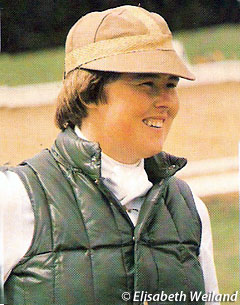
After that I went to Strömsholm (one of the three national equestrian centres in Sweden) and was there for two years. The teachers at the riding school where I started in Helsinki had all trained there so I wanted to go too. I was a private student for the first year, riding five horses a day, lots of young ones, four-year-olds, a young Dressage horse, a young jumper and an older Dressage horse and jumper. I competed up to Prix St George and jumped up to 1.50m classes. Now that I look back, I was already drifting towards Dressage when I was there.
Irish hunters
Then I returned to Finland and worked at a farm that imported Irish hunters. I competed them in Jumping but I had a few bad falls and I started to get fearful. I remember that it took six months for me to admit to myself that I was now a bit scared of falling, but it was easy for me to swop over to Dressage instead.
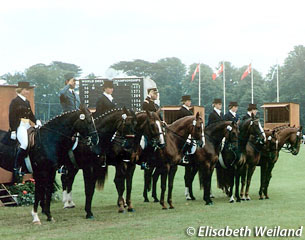
Piccolo got bog spavin, which in those days was not well treatable, so when the Los Angeles Olympic Games in 1984 were coming up I had no horse. By this time some of the stables at that riding school in Helsinki where I started became available to rent, so I took 21 boxes and started my own training and livery yard. It was a really good complex because it was owned by the town and had been built for the Helsinki Olympic Games in 1952.
A lot of my students took medals in Young Rider and Junior Championships, and during this time I also started training with Herbert Rehbein - a legend in riding - near Hamburg.
Students
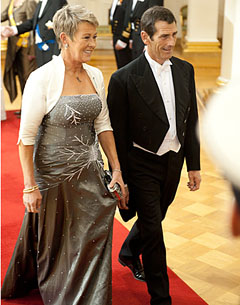
I also rode him at the first World Equestrian Games in Stockholm. He’d had a colic operation, which was a really big deal at the time, so he ended up with a hernia but he came back to normal and we got silver at that first WEG. Then I got a wildcard for the Dressage World Cup Final in Paris next year and we won!
I met my husband, Richard White who is English, and then I got an offer to go to Flyinge (national equestrian centre in Sweden) to ride and educate stallions and compete. We stayed there for eight years and Matador was sold to Japan.
When we were making the move to Sweden I went to a little national show before we left because we knew there were some horses coming over from St Petersburg to compete. And there I saw Edinburg. I was talking to a trainer who asked if I knew anyone who would like to have him. He was eight years old and schooled to Inter 2. It was a year before Barcelona (Olympic Games 1992, Spain) so I told him I was losing Matador and I would be interested. I managed to buy him, qualify him for the Games and we finished fifth there.
Atlanta
In Atlanta (1996 Olympic Games, USA), I had one of the Flyinge stallions, Amiral. Together we did some World Cup competitions, but unfortunately he suffered an eye injury at the Games. It was a stupid thing, a flexi-tie got caught in a haynet and he pulled back and it struck him in the eye.
Then for Sydney in 2000 we had a team qualified again. We had moved to England in 1998, first renting in Surrey and then moving to where we are now in Sussex. I love England, it’s a lot warmer than Finland!
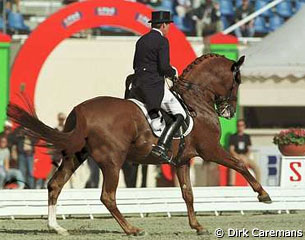
I qualified for Athens in 2004 with Andiamo, but he got an injury a few months beforehand so again I went again as a trainer only. Then along came Max who I had since he was a four-year-old and I went with him to the Beijing Games in 2008 in Hong Kong and we finished eighth in the Freestyle.
For London (in 2012) I didn’t have a horse so I was Swedish national team advisor and I also went to the Rio (2016) Games with them. Here in Tokyo I am with the Portuguese. I’ve been training in Portugal for 15 years and helping riders from time to time, but this year they came up with an official post for me. I’m also helping Cathrine Dufour (Denmark), she had a very good trainer in Denmark and I helped her before a long time ago. I have also been helping Heike Holstein (Ireland) a little bit here too.
Top riders
I have trained many top riders over the years - Nathalie zu Sayn-Wittgenstein (DEN), Emma Hindle (GBR), Imke Bartels (NED), Jan Brink (SWE) and many more. At the World Championships in Aachen (Germany in 2006) Richard and I had 10 students. His background is in National Hunt racing and he is not a Grand Prix rider, but from the start I found out that he has a great eye and is very honest about what he sees so he is an exceptional coach.
These are my 11th Olympic Games in Tokyo and it’s such a shame for the Japanese because the facilities here, the stabling and footing are all superb - that of course is the most important thing for the riders and our horses.
Changed
The sport has changed. When I started, all the know-how was in Germany and if you wanted to learn you had to go there. But a lot of trainers went there and brought the knowledge back to their own countries, so there is a lot more knowledge spread around the world today.
The horses have changed too. Before you took a horse and made it into a Dressage horse. Now you can just go out and buy one that has been specifically bred for the job. The sport is better too, more safety for the horses that’s for sure. And it is more sophisticated.

After the canter on the long side the music was supposed to change but it didn’t, so I went to the short side and still it didn’t change, so I went to the corner and still it didn’t change and then to the centre line when at last it changed. So I went into passage right away, but I had no idea where I was in the music anymore. I wanted to do the last piaffe one-handed and there was music for that, but again it didn’t stop, it just kept going, and we ended up doing 36 steps in the end. Luckily piaffe was very easy for Matador!
The most important thing to look for in a good Dressage horse? Conformation that makes it possible for them to do it. Matador had all of that. A hind leg naturally under so collection is easy, and a good neck. I believe that if they have three good gaits any horse can get to the Olympics and make a good picture. With three good gaits any rider can get 70% with good riding, but without good conformation your horse will not get 80%, it’s as simple as that...
-- by Louise Parkes for the FEI
Photos © Astrid Appels - Dirk Caremans - Elisabeth Weiland - FEI Archive
Related Links
Matador, a Scandinavian Fairytale
Corona Times: Hit & Run with Kyra Kyrklund
Kyra Kyrklund Awarded with Finnish Pro Sports Prize
Kyra Kyrklund, Making a Happy Day Every Day
Kyra Kyrklund and Jan Jönsson Appointed Professors of Equitation in Sweden